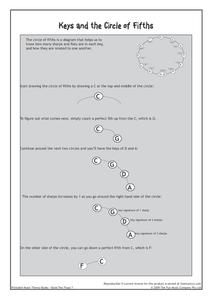Curated OER
Popular Music and Music Videos
This resource is part of a three-activity unit that introduces your class to the concept of popular culture and the role that it plays in their lives. Here, learners examine the importance of the music industry and music videos in pop...
Special needs in Music
Music Work Sheet (Special Ed)
Music is beneficial for all learners. Help your learners with special needs learn about different styles of music, as well as the ways that music is represented on paper, with 30 different worksheets.
SoundTree
Notating Friedrich von Schiller’s Theme to “Ode to Joy.”
To demonstrate their skills with traditional and computer-assisted notation, young musicians notate and perform the first eight measures of Friedrich von Schiller's theme to "Ode to Joy."
TED-Ed
A-rhythm-etic. The Math Behind the Beats
Your learners will dance in their seats as this talented drummer connects math to music in a short video clip. Clayton Cameron shows how math puts the "cool" in various genres of music, including jazz, hip-hop, pop, R&B, and others,...
Fun Music Company
Treasure Island Clues
In order to answer a music trivia question, young musicians must count the number of ties in a melody, name the final note, and use these clues to spell out Charlie Parker's nickname. This activity is not for the birds.
Fun Music Company
Completing Measures with Rests
Rests. Eighth rests, quarter rests, and half rests are the focus of a one-page worksheet that asks music theory students to complete a series of measures with rests and bar lines.
Fun Music Company
Treasure Island Clues: Scales
Which Beatle received the most fan mail? To answer this music trivia question, young musicians must employ their knowledge of scales, key signatures, and leading notes to find the letters that spell out the name of one of the famous mop...
Fun Music Company
Code Breaking with Music Symbols Representing Letters
Navajo code talkers beware! These kids use music symbols to break the codes and find both the question and the answer to a music trivia question.
Fun Music Company
Treasure Island Clues: Rhythm
Designed for rhythm level 1, the two games in this packet ask young musicians to identify the number of beats represented by a series of notes and notations, and then to use those numbers to answer a music trivia question.
Fun Music Company
Note Values
Note values are the focus of a short worksheet that asks young musicians to respond to short-answer questions and to complete a measure with notes of the appropriate value.
Fun Music Company
Compound Time
To demonstrate their understanding of simple and compound time signatures, young musicians complete a chart by drawing quarter or dotted quarter notes equal in value to the note groups shown.
Fun Music Company
Intervals
As part of their study of intervals, musicians are asked to draw the interval indicated above the notes provided on the worksheet.
Fun Music Company
The Harmonic Minor Scale
The harmonic minor scale, including the use of accidentals, is the focus of a one-page worksheet that includes instructional information and practice exercises.
Fun Music Company
Transposition
Up a perfect fifth, down an octave. Transposing a piece to suit the range of singers, and instrumentalists, is a key skill musicians must perfect. This worksheet explains how to transpose and gives learners a change to practice.
Fun Music Company
Working Out the Key
"Gimme an E minor!" Or any key for that matter. But how do you figure out the key of a piece of music? Here's a worksheet that shows young musicians three easy steps to help them identify the key of a piece of music.
Fun Music Company
Classification of Intervals
Major 2nd, Perfect 4th, Minor 3rd. The number and classification of intervals are the focus of a one-page worksheet that asks musicians to write the intervals above given notes and to indicate the classification of others.
Fun Music Company
Relative Major and Minor
It's all relative. Young music theorists are asked to count to three and identify the relative major and minor keys of keys that share the same signature.
Fun Music Company
Writing Major Scales
Designed as an assessment of understanding, this one-page learning exercise asks musicians to demonstrate their understanding of scales by drawing C, G, and F Major scales on the provided staffs.
Fun Music Company
The Bass Clef
Every Good Boy, and girl for that matter, will do just fine with this activity as they are asked to correctly trace and then draw bass clefs on the provided worksheet.
Fun Music Company
The Treble Clef
Gee, your young musicians should have no trouble tracing the treble clefs on this worksheet. Once they have mastered this tricky signature, they place it correctly on a staff.
Fun Music Company
The C Major Scale
Your young musicians will take note of this worksheet that asks them to mark the half steps in a C major scale and then write the scale in both treble and bass clef.
Fun Music Company
Keys and Circle of Fifths
How sharp are your young musicians? Can they perfectly identify the sharps and flats in each key by completing a circle of fifths diagram? There is solid theory behind this exercise.
WHB Elementary School Band
Circle of Fifths: Major Keys
How many sharps and flats are their in each of the major keys? Help keep your young musicians sharp with a printable template that models how to identify the signature for the major keys' sharps and flats.
Let's Drum!
Let's Drum!
Here's a group of exercises designed to introduce a group or class to the rhythm, as well as the basic sounds of a drum, bass and tone. Individuals investigate different types of drums and form drum circles to practice traditional rhythms.

























